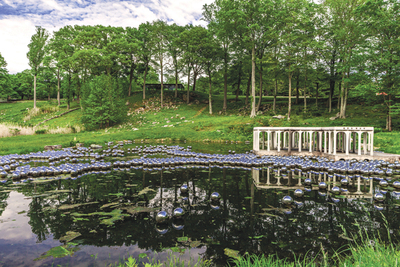Yayoi Kusama: Narcissus Garden
Yayoi Kusama, Narcissus Garden at the Glass House, 1966–2016, 1,300 steel balls in the Pond Pavilion, built in 1962. Photo: Matthew Placek.
Philip Johnson’s Glass House, an iconic glass and steel Modernist structure, nestles on 49 acres of land with hawks overhead and a stream-fed lake below. This “50-year diary,” as Johnson called it, was his treatise on minimalism, geometry, and proportion.
“Johnson studied philosophy and classics as an undergrad and was very interested in Platonic forms. On the property, you have these pure geometric rectangles and circles repeating,” says Irene Shum, Curator and Collections Manager. Add to this composition, Yayoi Kusama’s Narcissus Garden—a three-part installation celebrating the 110th anniversary of Johnson’s birth and the 10th anniversary of the opening of his property to the public.
In the first part, 1,300 stainless steel balls, 12 inches in diameter, float around the pond. They reflect the clouds and light above and the shadow below—gliding and wafting according to the weather. They flit to the edges, or clump together, making the sound of popping popcorn when they collide.
When Narcissus Garden first went into the pond, the frogs surfaced to investigate. In true Narcissus fashion, they croaked in delight (or maybe horror) as they spied their greenish brown amphibian faces probably for the first time reflected back at them.
Kusama, known as the “polka dot princess” is a Japanese artist famous for her psychedelic colors, repeating patterns and…polka dots. The original Narcissus Garden, made in 1966 for the 33rd Venice Biennale, consisted of 1500 plastic, silver globes that were all over the Pavilion lawn. Images of the surroundings—artists, artwork, nature—reflected in their convex surface. She put up a sign, “Your Narcissium [Sic] For Sale” and sold them for two dollars each.
The second part of the exhibition, PUMPKIN (2015), is an enormous polka-dotted, bulbous, steel fruit. Kusama grew up on a farm and always felt tenderness toward the pumpkin—its shape, humbleness, and color—and it appears regularly in her work.
For the last part of the exhibition, Dots Obsession, (for three weeks in September) the walls of the Glass House will be adorned with polka dots. All of these dots—floating, fixed, and always circular—dialogue exquisitely with Johnson’s vision.

